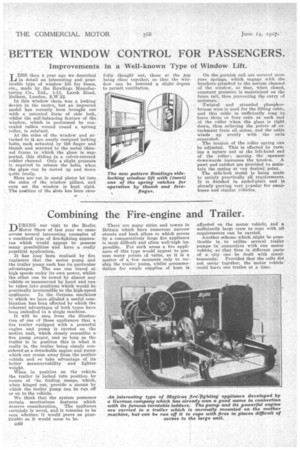BETTER WINDOW CONTROL FOR PASSENGERS.
Page 62

If you've noticed an error in this article please click here to report it so we can fix it.
Improvements in a Well-known Type of Window Lift.
LESS.than a year ago we described in detail an interesting and practicable type of window lift for buses, etc., made by the Rawlings Manufacturing Co., Ltd., 1-11, Larch Road, Balham, London, S.W.12.
In this window there was a locking device in the centre, but an improved model has recently been brought out with a patented form of side lock, whilst the self-balancing feature of the window, which is performed by concealed cables wound round a sprung roller, is retained.
At the sides of the window and atInched to it are neatly designed locking bolts, each actuated by OA finger and thumb and screwed to the metal channel frame in which the glass is supported, this sliding in a velvet-covered rubber channel. Only a slight pressure is required to release the bolts, when the glass can be moved pp and down quite freely.
Slots are cut in metal plates let into the sides of the window pillars, and once set the window is kept rigid. The position of the slots has been care fully thought out, those at the „top being close together, so that the window cau be lowered a slight degree to permit ventilation.
On the garnish rail are secured pressure springs, which engage with the. brackets attached to the bottom channel of the window, so that, when closed, constant pressure is maintained on the fence rail, thus preventing the entry of moisture.
Twisted and stranded phosphorbronze wire is used for the lifting cable, and this cable is sufficiently long to leave three or four coils at each end of the roller when the glass is right down' thus relieving the points of attachnaent from all stress, and the cable winds up evenly with the coils separated.
The tension of the roller spring can be adjusted. This is effected by turning a square nut at the left-hand end of the roller; moving the ,spanner downwards increases the tension. A pawl and ratchet are provided to mainthin the spring at 'my desired point. The side-lock model is being Made to satisfy practically all requirements. It is finished in nickel-plate and is already proving very popular for omnibuses and similar vehicles.












































































































